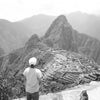Choquequirao (Southern Quechua: Chuqi K'iraw, Cradle of Gold) is a partly excavated ruined city of the Inca in the south of Peru. It bears a striking similarity in structure and architecture to Machu Picchu and is referred to as its 'sister'. Choquequirao receives far fewer tourists than its sister but the ruin is no less delightful and is a good alternative to the sometimes overcrowded Machu Picchu. Unlike Machupicchu, Choquequirao cannot be reached by train or bus. The only way to visit the site is to go on a scenic 2-day hike from outside Cusco.
The ruins at Choquequirao are composed of buildings and terraces at different levels from the lower level Sunch'u Pata to the truncated hill top. The hill top has been leveled and ringed with stones to form a platform of 30x50 meters wide.
Choquequirao (3,085 m) is situated amongst the spurs of the Salkantay Mountain Range in the Province La Convención in the Region Cusco above the Valley of the river Río Apurímac. The entire complex encompasses 1,800 hectares of which 30-40% is uncovered.
The site was most likely built during the reign of the Inca king Pachacuti Inca Yupanqui and is considered to be the last bastion of resistance and refuge of the Sons of the Sun who fled from the city of Cusco when it was under siege in 1535. Led by Manco Inca Yupanqui they took refuge in Choquequirao.
According to the Peruvian Tourism Office, "Choquequirao was probably one of the entrance check point to the Vilcabamba region, and also an administrative hub serving political, social and economic functions. Its urban design has followed the symbolic patterns of the imperial capital, with ritual places dedicated to the Sun (Inti) and the ancestors, to the earth, water and other divinities, with mansions for administrators and houses for artisans, warehouses, large dormitories or kallankas and farming terraces belonging to the Inca or the local people. Spreading over 700 meters, the ceremonial area drops as much as 65 meters from the elevated areas to the main square."
Presumably it was used as a check point for access to the Vilcabamba Area and as a cultural and religious center for the region. The city also played an important role as a link between the Amazon Jungle and the city of Cusco.
The typical Inca terraces form the largest constructions on site. A temple, some administrative buildings and the living quarters of the aristocrats are situated around the central square. On the outskirts of the site lie the living quarters of the common people grouped together in a small village. There are numerous water channels, aqueducts and water springs. Most of the buildings are well-preserved and well-restored. Restoration is still continuing.
The Peruvian Government is planning the construction of a cable car to reach the ruins. Others have proposed the development of a train similar to the one that goes from Cusco to Macchu Picchu.
According to Ethan Todras-Whitehill of the New York Times, Choquequirao's first non-Incan visitor was the explorer Juan Arias Díaz in 1710. The first written reference to the site dates to 1768 and was made by Cosme Bueno, but was ignored for the time being. In 1834 Eugene de Santiges rediscovered the site. In 1837 Leonce Agrand mapped the site for the first time, but his maps were soon forgotten. When Hiram Bingham, the discoverer of Machu Picchu, visited Choquequirao in 1909 the site gained more attention. The first excavations started some decades later in the 1970s.

